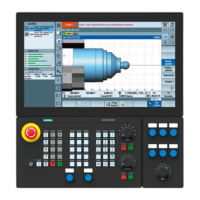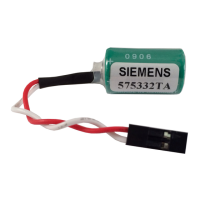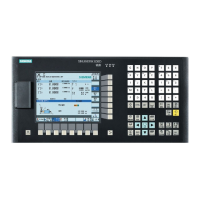2 General Information about Integrated Safety Systems 11.03
2.6 Basics of SINUMERIK Safety Integrated
© Siemens AG 2003 All Rights Reserved
2-32 SINUMERIK 840D/SIMODRIVE 611 digital SINUMERIK Safety Integrated (FBSI) - Edition 11.03
2.6 Basics of SINUMERIK Safety Integrated
2.6.1 Control category 3
The safety-relevant components of the SINUMERIK 840D control with
SIMODRIVE 611 digital correspond to Category 3 according to EN 954-1.
Table 2-5 Categories of safety-relevant parts of control systems
Cate-
gory
Summary of requirements System response
1)
Main principle
for provision
of safety
B The safety-relevant components of machine controls
and/or their protective equipment and components
must be designed, constructed, selected, assembled
and combined in compliance with all applicable
standards such as to be capable of withstanding all
potentially hazardous influences.
If a fault/error occurs, it can lead to
loss of the safety functions.
Selection of
components
1 The requirements of B must be fulfilled. Use of
components and principles that have proven to be
effective in terms of safety.
As described for category B, but
with a greater safety-relevant
reliability of safety functions.
2 The requirements of B must be fulfilled. Use of
principles that have proven to be effective in terms of
safety.
The safety function(s) must be tested at appropriate
intervals by the machine control.
Note:
The suitability of the measure depends on the
application and type of the machine.
The occurrence of a fault/error can
lead to a loss in safety functions
in-between tests.
The loss of safety function(s) is
detected in the course of testing.
Structure-
based
3 The requirements of B must be fulfilled. Use of
principles that have proven to be effective in terms of
safety.
The controls must be designed such that:
a single fault/error in the control system does not
cause a loss of the safety function, and
if it can be implemented in an appropriate way,
individual faults/errors can be detected.
If the single fault/error occurs, the
safety function always remains
operational.
Some, but not all, faults/errors are
detected.
An accumulation of undetected
faults/errors can lead to a loss of the
safety function(s).
4 The requirements of B must be fulfilled. Use of
principles that have proven to be effective in terms of
safety.
A control system must be designed such that:
a single fault/error in the control system does not
cause a loss of the safety function(s), and
the single fault/error is detected before or as the
safety function is required to take effect. If such a
response cannot be implemented, then the
accumulation of faults/errors must not result in a loss
of the safety function(s).
If faults/errors occur, the safety
function always remains
operational.
Faults/errors are detected promptly
enough to prevent any loss of safety
functions.
Structure-
based
1): The risk assessment states whether the total or partial loss of the safety function(s) as a result of faults/errors
is acceptable.
General

